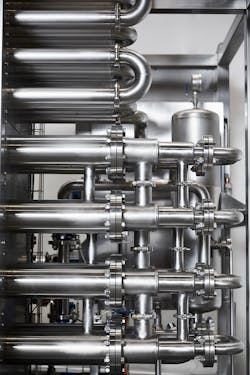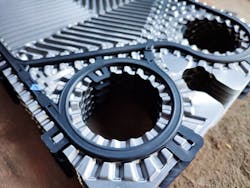The benefits of shell and tube over plate heat exchangers

For simple non-viscous fluids, the choice of heat exchanger normally comes down to a choice between plate heat exchangers (PHEs) and shell and tube designs. The proponents and manufacturers of both types of heat exchanger make strong cases for the use of each technology, and the suitability of each type of heat exchanger, but ultimately the heat transfer situation will determine the best heat exchanger for the role.
Having said that, there are a number of considerations that are not always taken into account when evaluating the advantages of shell and tube and plate heat exchangers. It is first important to understand the difference between the two designs, as this will then make it easier to understand the differences in costs, operational efficiency and maintenance.
As the name suggests, a plate heat exchanger consists of a series of pressed metal plates separated by gaskets. The service fluid (which provides the heating or cooling effect) and the product (the material to be heated or cooled) flow through the gaps between alternate plates. In contrast a shell and tube design features a tube (or series of tubes) running through a shell. The product flows through the tube and the service fluid through the gap between the tube and the shell.
Advantages of plate heat exchangers include their simplicity and high heat exchange performance (when used with simple fluids). However, the capital costs of the two technologies are not always clear cut. Neither are the differences in pressure drop created by the two designs, but tubular heat exchangers are generally capable of operating at higher temperatures.
While PHEs often require less space than tubular units, the exact size difference depends on the design of the tubular unit being compared. Heat exchangers that use corrugated tube technology (like HRS tubular heat exchangers) to increase thermal efficiency can provide equivalent heat exchanger performance in a smaller package than traditional smooth-tube designs.
Another claimed benefit for PHEs is that they are easy to dismantle and clean but removing lots of separate plates and their corresponding gaskets is not particularly convenient. It also ignores the fact that well designed tubular heat exchangers are less likely to need regular dismantling to allow for deep cleaning, and that this can be facilitated by using removable tubes.
Many manufacturers of PHEs will claim that their designs will operate for years without the need of maintenance but will also admit that cleaning (which often involves similar levels of disassembly to servicing) depends on the viscosity, fouling and scaling potential of the product. In other words, admitting that real world performance is much less impressive than the theory. In contrast, corrugated shell in tube heat exchangers are specifically designed to reduce fouling, meaning that their performance parameters are based on real-world operational situations.
Obviously, the total cost of ownership (a combination of the capital cost and operational costs over the working life of the unit) is a major factor when considering which type of heat exchanger to invest in. Proponents of PHEs will claim that they provide the lowest cost of ownership, but they rarely mention one of the biggest maintenance costs involved in running plant heat exchangers – gasket replacement.
The gaskets between each plate are an inherent design feature of PHEs but are prone to failure, particularly when operating at high temperatures. This is particularly true where operation involves many repeated heating and cooling cycles, which stress both the gasket material, but also the metal plates which are often just 0.5-0.6 mm thick. Even when they do not fail, regular gasket replacement is often part of the standard service requirement. This means that the price of gaskets needs to be considered in the overall cost of ownership, along with the down time and direct servicing costs. Because most shell and tube designs are of welded construction, there are no internal gaskets to fail or replace. Where removable tubes are used, O-ring gaskets are the norm, making them much easier and cheaper to replace than the bespoke gasket designs required for plate heat exchangers.
Once the cost of gasket replacement is factored in over the life of a plate heat exchanger, then the total cost of ownership assessment swings back towards shell and tuber heat exchangers. With much simpler routine maintenance and cleaning, and no need for the regular replacement of expensive, bespoke gaskets, more and more users are appreciating the benefits of shell and tube heat exchangers.
